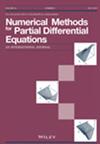Analysis of two fully discrete spectral volume schemes for hyperbolic equations
IF 1.7
3区 数学
Q1 MATHEMATICS, APPLIED
引用次数: 0
Abstract
Abstract In this paper, we analyze two classes of fully discrete spectral volume schemes (SV) for solving the one‐dimensional scalar hyperbolic equation. These two schemes are constructed by using the forward Euler (EU) method or the second‐order Runge–Kutta (RK2) method in time‐discretization, and by letting a piecewise k th degree( is an arbitrary integer) polynomial satisfy the local conservation law in each control volume designed by subdividing the underlying mesh with Gauss–Legendre points (LSV) or right‐Radau points (RRSV). We prove that for the EU‐SV schemes, the weak (2) stability holds and the norm errors converge with optimal orders , provided that the CFL condition is satisfied. While for the RK2‐SV schemes, the weak (4) stability holds and the norm errors converge with optimal orders , provided that the CFL condition is satisfied. Here and are, respectively, the spacial and temporal mesh sizes and the constant is independent of and . Our theoretical findings have been justified by several numerical experiments.双曲型方程的两种完全离散谱体积格式的分析
摘要本文分析了求解一维标量双曲型方程的两类完全离散谱体积格式。这两种方案分别使用前向欧拉(EU)方法或二阶龙格-库塔(RK2)方法在时间离散化中构造,并通过将下层网格细分为高斯-勒让德点(LSV)或右拉道点(RRSV),使分段k次(任意整数)多项式满足每个控制体积的局部守恒律。证明了在CFL条件满足的情况下,EU - SV方案具有弱(2)稳定性,范数误差收敛于最优阶。而对于RK2 - SV格式,只要满足CFL条件,则保持弱(4)稳定性,范数误差收敛于最优阶。这里和分别是空间和时间网格尺寸,常数与和无关。我们的理论发现已被几个数值实验所证实。
本文章由计算机程序翻译,如有差异,请以英文原文为准。
求助全文
约1分钟内获得全文
求助全文
来源期刊
CiteScore
7.20
自引率
2.60%
发文量
81
审稿时长
9 months
期刊介绍:
An international journal that aims to cover research into the development and analysis of new methods for the numerical solution of partial differential equations, it is intended that it be readily readable by and directed to a broad spectrum of researchers into numerical methods for partial differential equations throughout science and engineering. The numerical methods and techniques themselves are emphasized rather than the specific applications. The Journal seeks to be interdisciplinary, while retaining the common thread of applied numerical analysis.

 求助内容:
求助内容: 应助结果提醒方式:
应助结果提醒方式:


